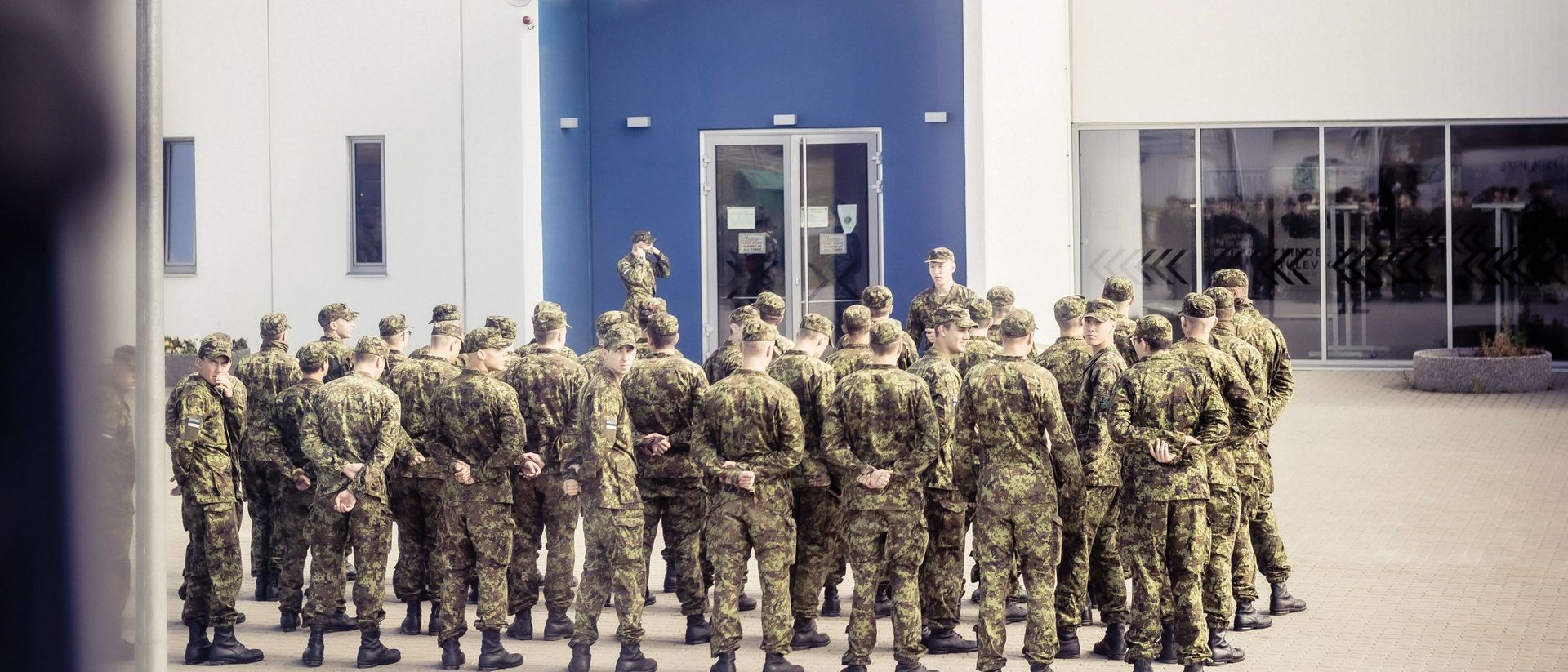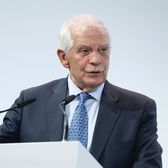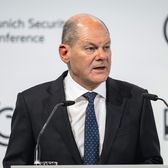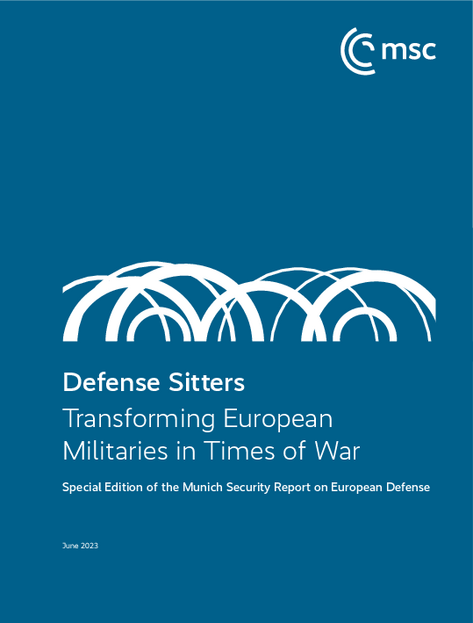

Money Can(’t) Buy You Force
Defense Budgets
 AuthorIsabell Kump
AuthorIsabell Kump AuthorJintro Pauly
AuthorJintro Pauly
 AuthorIsabell Kump
AuthorIsabell Kump AuthorJintro Pauly
AuthorJintro Pauly
Key Points
In response to Russia’s invasion of Ukraine, 20 EU member states have pledged to significantly increase their defense spending. Countries now need to live up to their promises and further increase them to strengthen European armed forces and contribute more to transatlantic burden-sharing.
The new funding offers EU member states the opportunity to close pre-existing capability gaps, which have been widened by their military assistance to Ukraine. At the same time, Russia’s war on Ukraine has also created new capability gaps in Europe.
Europe’s habitually uncoordinated responses to the war risk worsening the perennial fragmentation of its defense industrial base. Moreover, EU member states are exporting their fragmentation to Ukraine.
EU member states are facing various dilemmas regarding how to prioritize the additional funds. These include whether they should focus on filling long-standing capability gaps or investing in new technologies and whether they should invest in more European defense cooperation or prioritize a swift rebuilding of military capabilities.
The announced increases in EU member states’ defense budgets, if realized, would put an end to decades of underinvestment. Continuous budget cuts, starting with the cashing in of the peace dividend after the Cold War and exacerbated by austerity policies and uncoordinated cuts in the aftermath of the 2008 financial crisis, have resulted in a major and lasting depreciation of EU member states’ armed forces.[1] This has led to a relative loss of the EU’s combined military strength. While the US, Russia, and China increased their defense budgets by 65.7 percent, 292 percent, and 592 percent respectively between 1999 and 2021, combined EU defense spending only increased by 19.7 percent.[2]
The trend of decreasing military budgets was reversed after Russia’s 2014 annexation of Crimea, which led several EU member states to increase their defense spending for the first time in years. Since 2015, EU member states’ collective defense expenditure has steadily increased, with 2021 marking the seventh consecutive year of real growth.[3] Nevertheless, European defense has remained underfunded, perpetuating Europe’s dependence on the US.[4] According to the NATO Secretary General’s Annual Report 2022, only five countries that are members of both the EU and NATO met the goal of spending two percent of GDP on defense in 2022: Greece, Lithuania, Poland, Estonia, and Latvia.[5]
Defense Spending Increases: From Promise to Practice
20 EU member states have promised increases in defense spending since Russia’s invaded Ukraine in February 2022, which on paper are far more significant than those implemented after 2014 (Figure 2.2). In his famous Zeitenwende speech, delivered three days after the start of Russia’s war on Ukraine, German Chancellor Olaf Scholz announced the establishment of a 100 billion euro special fund (Sondervermögen) and pledged that Germany would spend two percent of its GDP on defense “from now on.”[6] In January 2023, French President Emmanuel Macron declared his country would reach NATO’s two percent goal by 2025 and that its military spending would increase by a third by 2030.[7] Some days later, Polish Prime Minister Mateusz Morawiecki made the commitment that his country would spend 4 percent of its GDP on defense in 2023.[8] In terms of the share of GDP spent on defense, Warsaw would then even be ahead of Washington.[9] Unsurprisingly, Russia’s war has also led the Baltic states to significantly increase their defense spending. Estonia, Latvia, and Lithuania have all pledged to increase their defense spending to 2.5 percent of their respective GDPs.[10] If EU member states met these spending pledges, their combined annual defense expenditure would increase by 61 percent by 2028, or 400 billion euros in real terms (Figure 2.1). EU member states would then on average spend 1.8 percent of GDP on defense by 2028.
Potential increase in annual defense spending of EU member states, 2022–2028, billion EUR
If translated into increased military capabilities, these investments will also contribute to more equal burden-sharing between the US and European NATO allies. A comparison between EU and US forecasts shows that the transatlantic spending gap could shrink from 2.4 percentage points in 2020 to 1.3 percentage points by 2028 (Figure 2.3).[11] This may partly defuse bipartisan criticism in the US that Europe does not pull its weight in providing for its own security. Greater burden-sharing would also better prepare Europe for a scenario in which the US limits its engagement in Europe’s security.[12] In light of the intensifying rivalry between the US and China, as well as the possibility of yet another US president coming into office who openly questions the relevance of the transatlantic alliance, this is a plausible scenario.[13] However, even these new spending commitments are not enough for the EU to collectively meet NATO’s spending two percent goal – which could even be reconceptualized as a floor, not a ceiling, at NATO’s July summit in Vilnius. Europeans cannot be complacent and need to further increase their defense spending.
EU member states’ spending pledges in response to Russia’s invasion of Ukraine, percent
EU-27 vs. US defense spending, 2013–2028, percent
However, some states are already struggling to live up to their promises. According to Eva Högl, German Parliamentary Commissioner for the Armed Forces, as of February 2023, Germany had not yet spent “a single euro” from its 100 billion euro special fund.[14] The country will only reach the two percent goal in 2024 – and only with the help of the special fund.[15] Once the fund is exhausted, however, it is unclear whether Germany will be able to meet NATO’s two percent goal.[16] In the same vein, Italy is expected to fall short of its announced objective of reaching the two percent in 2028.[17] Furthermore, the extent to which EU member states have increased their defense spending varies significantly. While the announced increases in Eastern and Central Europe mean that they would soon exceed NATO’s two percent goal, others such as Spain are only planning to do so from 2029 onwards.[18] Belgium does not intend to meet the target before 2035.[19]
These variations indicate that, despite the overall convergence of threat perceptions on Russia – as seen inter alia in NATO’s new Strategic Concept and the EU’s Strategic Compass – the sense of urgency between North-Eastern and South-Western European countries still differs.[20] France and Italy, for instance, still seem to prioritze the EU’s Southern Neighborhood. And although defense spending of countries in Central and Eastern Europe will remain lower in real monetary terms, their influence in the EU and NATO will likely increase as they have shown strong commitment in keeping their pledges. This may ultimately contribute to the power balance in both organizations shifting in favor of Central and Eastern Europe.[21]
In addition, economic factors could reduce both the impact of these extra funds and the willingness of member states to live up to their promises. Inflation amounted to 6.9 percent in the eurozone in March 2023 and was highest in the Baltic countries, with rates ranging between 15.2 to 17.2 percent.[22] If unchecked, it will eat up part of the announced defense investments. According to recent estimates, only 50 to 70 billion euros could be left of Germany’s special fund to spend on hardware after inflation and additional costs are priced in.[23] Meanwhile, limited economic growth in the coming years, a consequence of both the pandemic and disruptions caused by Russia’s war on Ukraine, will increase domestic distributional conflicts. After a rebound of GDP growth in 2021 to 5.4 percent, the EU economy is expected to only grow at 0.8 percent and 1.6 percent in 2023 and 2024 respectively.[24] Prioritizing defense investment over social spending will thus become more difficult for many policymakers.

After the Cold War, we shrunk our forces to bonsai armies.[25]
Josep Borrell•EU High Representative for Foreign Affairs and Security Policy, EEAS Blog, August 27, 2022
Capability Gaps: What Money Can(’t) Buy
Despite these challenges, it is imperative that EU member states meet and up their defense spending pledges to face the current deteriorating security environment. After largely neglecting their promises made at the 2014 Wales summit, European NATO allies cannot afford to kick the can down the road any further. Part of the additional funding will have to be used to make up for years of underspending and to close the capability gaps that have arisen in European militaries since the 1990s. These long-standing gaps include air-to-air refueling and long-distance air lift.[26] European inventories have additionally suffered large reductions across several equipment categories of the EU member states’ air, maritime, and land forces. For example, the number of main battle tanks decreased by 80 percent between 1992 and 2021, while the number of 152mm/155mm artillery and multiple launch rocket systems fell by 64 percent and 48 percent respectively (Figure 2.4).
Reductions in selected EU countries' inventories across equipment categories prior to Russia's invasion of Ukraine, 1992 and 2021, number of equipment pieces and percent
The military assistance provided to Ukraine since the onset of the war has exacerbated these pre-existing capability gaps and accelerated the reduction of inventory levels. EU member states have sent significant quantities of military hardware to Ukraine, including various types of main battle tanks, armored vehicles, fighter jets, artillery systems, and air-defense systems.[27] Between November 2022 and February 2023 alone, Poland, Spain, and the Netherlands, for instance, delivered a total of 46 main battle tanks to Ukraine.[28] In the same period, EU member states sent 39 152/155 howitzers and two multiple launch rocket systems to Ukraine.[29] These donations further reduced the countries’ land equipment holdings throughout the EU. From November 2021 until February 2023, the stocks of 152mm/155mm artillery of the Netherlands, Poland, and Spain, for instance, reduced by 19.6, 12, and 10 percent respectively. In the same period, Poland’s inventory of main battle tanks saw a 20.6 percent decrease.[30] EU member states thus have to replenish and expand depleted stocks urgently to ensure that this support can be sustained in the future.
Faced with widening, long-standing gaps and short-term needs, EU member states need to prioritize which capability gaps to fill. To do so, the EU heads of state or government tasked the European Commission and European Defence Agency (EDA) at the Versailles Summit in March 2022 to produce an analysis of defense investment gaps. The analysis, presented in May 2022, assessed the state of the EU’s armed forces and issued recommendations on how to fill the most pressing gaps. The short-term priorities include, for instance, replenishing stockpiles, replacing Soviet-made equipment with more modern European solutions, and strengthening EU states’ multilayer air and missile defense systems.[31]
Russia’s war on Ukraine has not only widened Europe’s long-standing capability gaps but also created new ones. For instance, it has demonstrated the relevance of several types of drones, ranging from larger ones armed with guided missiles to small commercial ones used for Intelligence, Surveillance, and Reconnaissance (ISR) purposes. At present, they still play a comparatively small role in the EU member states’ armed forces.[32] However, as the war in Ukraine shows, their role in the future of warfare will only increase (Chapter 3).
Finally, Russia’s invasion of Ukraine has also underlined Europe’s continued dependence on the US. Past events, such as the chaotic evacuation of US and European citizens from Afghanistan in August 2021, reconfirmed Europe’s reliance on US high-end capabilities. These include air-to-air refueling and long-distance air lift as well as suppression of enemy air defenses and C4ISR (command, control, communications, computers, and ISR).[33] Recent analyses of the capacity of EU member states in the face of an actual war have shown how ill-prepared Europe still is. Germany would, for instance, only have munitions for two days of fighting.[34] Ramping up the production of ammunition, however, appears to be a difficult task at present, as NATO Secretary General Jens Stoltenberg warned in February 2023: “The waiting time for large-scale ammunition has increased from 12 to 28 months. Orders placed today would only be delivered two-and-a-half years later.”[35] Greater efforts to close long-standing and new gaps are therefore essential to ensure better transatlantic burden-sharing and mitigate the risks that come with Europe’s security reliance on the US.
European Fragmentation: Debilitating Diversity
The fragmented EDTIB is, however, a central impediment to closing long-standing and new capability gaps.[36] Unlike in other areas of the economy, there is no European single market for defense but rather 27 national markets with high entry barriers for outside competition. As a result, European defense companies tend to produce small volumes of the same type of arms, which is not only inefficient but also hampers interoperability.[37]
This fragmentation has led EU member states to use a much greater variety of different types of weapon systems than the US. The MSC’s 2017 European Defense Report, a research project with McKinsey and the Hertie School’s Centre for International Security Policy, showed that, in 2016, European member states used 178 different major weapon systems, whereas the US military only used 30.[38] For example, EU member states used a significantly wider range of different types of main battle tanks (17 versus 1), destroyers/frigates (29 versus 4), and fighter planes (20 versus 6) than the US. The situation has hardly improved since then. This fragmentation is worsened by the proliferation of national requirements and standards. These have often resulted in the production of multiple variants of certain military equipment. A case in point is the NH90 helicopter, which exists in over 20 different configurations.[39] This customization creep also obstructs collaborative development and procurement efforts among EU member states, making them more complex and costly.
Data from the 2022 Defense Gaps Analysis by the European Commission and EDA shows that, between 2007 and 2016, EU member states spent more than 60 percent of their defense procurement budgets on such imports, causing further underinvestment in the EDTIB.[40] Under pressure to replace weapon systems donated to Ukraine and to rearm as fast as possible, European member states have recently aggravated the fragmentation of the EDTIB by opting for available off-the-shelf procurement options rather than investing in European weapon systems that would decrease fragmentation but take longer to procure.[41] Such off-the-shelf options often include hardware produced in non-EU countries.
A case in point is Germany: Since February 2022, it has ordered US-made F-35 fighter jets and Chinook heavy-lift helicopters and the Israeli-made Arrow-3 air-defense systems.[42] The European Sky Shield Initiative, presented by Germany as a joint European project to develop a layered air-defense capability for Europe, envisions the procurement of German, US, and Israeli air-defense systems. Yet, it has been criticized by France for its reliance on non-European systems.[43] Poland, in turn, has invested in a range of non-European weapon systems, including K2 Black Panther main battle tanks, K239 Chunmoo multiple rocket launchers, and FA-50 fighter jets from South Korea.[44] In addition, it has ordered M1 Abrams main battle tanks and HIMARS multiple rocket launchers from the US.[45] Some of these systems were not used in Europe until Poland acquired them and thus add to the fragmentation of Europe’s defense landscape.[46] This procurement decision was primarily motivated by the acute threat Russia poses to Poland, leading Warsaw to prefer the early availability of off-the-shelf systems over the interoperability advantages of European systems that would take longer to procure. In addition, the recent Polish-German disagreements about the donation of Poland’s German-made heavy weaponry to Ukraine may have also played into the country’s decision to look for arms suppliers elsewhere.[47]

In order to invest this funding in a meaningful and sustainable manner, we need a high performing and competitive arms industry in Germany and Europe as a whole.[48]
Olaf Scholz•German Chancellor, Munich Security Conference, February 17, 2023
Since Ukraine has received military support from many European partners, and these partners use a wide variety of different systems, the EU has essentially exported its fragmentation.[49] In this regard, the Ukrainian Defense Minister Oleksii Reznikov described the combination of different weapon systems in Ukraine’s army as a “military zoo.”[50] Ukraine has, for example, received five different types of main battle tanks from EU partners, including variations of the Leopard 2 and 1 as well as a variety of different Soviet-era tanks.[51] This poses a great logistical challenge to Ukraine in terms of training and in navigating the complex logistics of maintaining and repairing a huge variety of weapon systems that all require their own types of spare parts while defending itself against Russia’s aggression.
Conclusion: Spending More and Spending Better
The increases in defense spending by numerous EU member states after decades of underinvestment is good news – if Europeans keep and further raise their pledges. With more financial resources, they have the chance to fill capability gaps and shortfalls in their military inventories and invest in the European defense technological and industrial base. The question now is how exactly these resources should be used. EU member states are facing various dilemmas, such as whether to focus on filling long-standing capability gaps or investing in new technologies that have proven effective in the war in Ukraine. Another dilemma facing EU member states is whether to invest in more European defense cooperation or prioritize a swift rebuilding of military capabilities by opting for the earliest-available off-the-shelf procurement option, even if this is not a European system. EU member states will now have to address the questions of what to prioritize in procurement, and how to procure better together.

Defense Sitters — Munich Security Report Special Edition
Nicole Koenig, Leonard Schütte, Natalie Knapp, Paula Köhler, Isabell Kump, and Jintro Pauly, “Defense Sitters: Transforming European Militaries in Times of War,” Munich: Munich Security Conference, Special Edition of the Munich Security Report, June 2023, https://doi.org/10.47342/LIHA9331
Download PDF 2 MB- [1] Max Bergmann et al., “Transforming European Defense,” Washington, DC: CSIS, CSIS Briefs, August 2022, perma.cc/6NRS-VPC4, 1–2; Sophia Becker, Christian Mölling, and Torben Schütz, “Deterrence and Defense in Times of Covid-19: Europe’s Political Choices,” Berlin: DGAP, DGAP Policy Brief 9, April 2020, perma.cc/SMN8-23NX, 2.
- [2] SIPRI data quoted in European Commission, “Joint Communication to the European Parliament, the European Council, the Council, The European Economic and Social Committee and the Committee of the Regions on the Defence Investment Gaps Analysis and Way Forward,” Brussels: European Commission, May 18, 2022, perma.cc/AR28-5RQB, 4.
- [3] EDA, “European Defence Spending Surpasses €200 billion for the First Time,” Brussels: EDA, December 8, 2022, perma.cc/C8SP-G88A.
- [4] Bergmann et al., “Transforming European Defense,” 2–3; Max Bergmann and Sophia Besch, “Why European Defense Still Depends on America: Don’t Believe the Hype - the War in Ukraine Has Led to Little Change,” Foreign Affairs, March 7, 2023, perma.cc J84P-G85G.
- [5] NATO, “The Secretary General’s Annual Report 2022,” Brussels: NATO, March 21, 2023, perma. cc/8TXR-85PA, 52.
- [6] Olaf Scholz, “Policy Statement by Olaf Scholz, Chancellor of the Federal Republic of Germany and Member of the German Bundestag, 27 February 2022 in Berlin,” Berlin: German Bundestag, February 27, 2022, perma.cc/7ED5-PXM4.
- [7] “Macron Announces Military Spending to Increase by a Third Until 2030,” Le Monde, January 20, 2023, perma.cc/873V-XN8H.
- [8] “Poland to Ramp up Defense Budget to 4% of GDP,” Deutsche Welle, January 30, 2023, perma. cc/2KJ2-RBJD.
- [9] “Poland to Ramp up Defense Budget to 4% of GDP,” Deutsche Welle.
- [10] IISS, “The Military Balance 2023: The Annual Assessment of Global Military Capabilities and Defense Economics,” London: IISS, 1st, February 15, 2023, perma.cc/6RPJ-MN38, 64.
- [11] This decrease would, however, also stem from the forecasted decline in US spending in the coming years.
- [12] Hans Binnendijk, Daniel S. Hamilton, and Alexander Vershbow, “Strategic Responsibility: Rebalancing European and Trans-Atlantic Defense,” Washington, DC: Brookings Institution, June 24, 2022, perma.cc/NB2F-24VC.
- [13] Bergmann and Besch, “Why European Defense Still Depends on America”; Aneta Zachová and Davide Basso, “Czech President: EU Army no Longer in Macron’s Mind,” Euractiv, March 3, 2023, perma.cc/GM8K- 42VC.
- [14] Die Wehrbeauftragte des Deutschen Bundestages, “Jahresbericht 2022 der Wehrbeauftragten (64. Bericht),” Berlin: Deutscher Bundestag, February 28, 2023, perma.cc/J5KG-X6YV.
- [15] “Europe is Struggling to Rebuild Its Military Clout,” The Economist, May 7, 2023, perma.cc/T6Q4-XXNF.
- [16] “Deutschland verfehlt Zweiprozentziel bei Verteidigungsausgaben,” Zeit Online, August 15, 2022, perma.cc/75UU-P7ND.
- [17] “Europe is Struggling to Rebuild Its Military Clout.”
- [18] Angelo Amante, “NATO Wants Italy to Hit Spending Target as Soon as Next Year, Minister Says,” Reuters, February 16, 2023, perma.cc/5225-76WV; Joseph Wilson, “Spain Boosts Military Spending to Close Gap With NATO Goal,” AP, July 5, 2022, perma.cc/6RXL-L63Z.
- [19] Andreas Kockartz, “Belgiens Regierung erhöht den Verteidigungsetat um 2 % des BIP,” VRT NWS, June 19, 2022, perma.cc/4JKR-U74H.
- [20] “Europe is Struggling to Rebuild Its Military Clout,” The Economist.
- [21] Eoin Drea, “With Ukraine War, EU Balance of Power Shifts East: Russia’s War Has Opened up a Vast Strategic Chasm Within the European Union,” Foreign Policy, June 21, 2022, perma.cc/B94M-NHWG; David Hutt, “Central and Eastern Europe Want More Security Clout. Will Increased Spending be Enough?,” Euronews, February 14, 2023, perma.cc/X9ER-Y9Z8.
- [22] Eurostat, “Euro Area Annual Inflation up to 7.0%,” Luxembourg: Eurostat, euroindicators 52/2023, May 2, 2023, perma.cc/W3VL-RXL5.
- [23] Ben Knight, “What Happened to the German Military’s €100 Billion Fund?,” Deutsche Welle, February 28, 2023, perma.cc/7TY2-KXCS.
- [24] European Commission, “European Economic Forecast: Winter 2023,” Luxembourg: European Commission, European Economy Institutional Paper 194, February 2023, perma.cc/Y4RU-DXZZ, 1; Eurostat, “EU’s GDP up by 5.4% in 2021 but Still Below 2019 Level,”: Eurostat, June 29, 2022, perma.cc/K9NS-4VVW.
- [25] Paul Taylor, “How to Spend Europe’s Defense Bonanza Intelligently,” POLITICO, September 2, 2022, perma.cc/8G78-K4QK.
- [26] Yvonni-Stefania Efstathiou, “European Strategic Airlift: a Work in Progress,” London: IISS, Military Balance Blog, January 10, 2019, perma.cc/JL37-AK5H; Andrea Aversano Stabile and Giorgio Di Mizio, Yvonni-Stefania Efstathiou, “European Strategic Airlift: a Work in Progress,” London: IISS, Military Balance Blog, January 10, 2019, perma.cc/JL37-AK5H; Andrea Aversano Stabile and Giorgio Di Mizio,
- [27] Joost Oliemans and Stijn Mitzer, “Answering the Call: Heavy Weaponry Supplied to Ukraine,” Oryx, April 11, 2022, perma.cc/E6AY-EAPT.
- [28] Analysis by McKinsey based on data provided by Institute for the World Economy, “Ukraine Support Tracker: A Database of Military, Financial and Humanitarian Aid to Ukraine,” Kiel: Institute for the World Economy, April 4, 2023, perma.cc/5XUK-JCMC; Christoph Trebesch et al., “The Ukraine Support Tracker: Which Countries Help Ukraine and How?,” Kiel, Kiel Working Paper 2218, February 2023, perma.cc/CNN8-6UMJ; IISS, “The Military Balance 2023”; IISS, “The Military Balance 2022: The Annual Assessment of Global Military Capabilities and Defense Economics,” London: IISS, 1st, February 15, 2022, perma.cc/SBQ7-3Z2U; Deliveries by the Netherlands consist of main battle tanks purchased for donation to Ukraine specifically. They were acquired from various sources, such as from Germany and the Czech Republic. See Oliemans and Mitzer, “Answering the Call: Heavy Weaponry Supplied to Ukraine.”
- [29] Analysis by McKinsey based on data provided by Institute for the World Economy, “Ukraine Support Tracker”; Trebesch et al., “The Ukraine Support Tracker”; IISS, “The Military Balance 2023”; IISS, “The Military Balance 2022.”
- [30] Analysis by McKinsey based on data provided by Institute for the World Economy, “Ukraine Support Tracker”; Trebesch et al., “The Ukraine Support Tracker”; IISS, “The Military Balance 2023”; IISS, “The Military Balance 2022.”
- [31] European Commission, “Joint Communication to the European Parliament, the European Council, the Council, The European Economic and Social Committee and the Committee of the Regions on the Defence Investment Gaps Analysis and Way Forward.”, 7.
- [32] Nico Lange, “How to Beat Russia: What Armed Forces in NATO Should Learn From Ukraine's Homeland Defense,” Bratislava: Globsec, February 2023, perma.cc/K6B6-AJXH, 21–22.
- [33] Bergmann et al., “Transforming European Defense.”
- [34] James Angelos, “Can Germany be a Great Military Power Again?,” The New York Times Magazine, January 24, 2023, perma.cc/L6HF-6RJW.
- [35] Jens Stoltenberg, “Pre-Ministerial Press Conference by NATO Secretary General Jens Stoltenberg ahead of the meetings of NATO Defense Ministers,” Brussels: NATO, February 13, 2023, perma.cc/5M7U-7ZBC.
- [36] Nathalie Tocci, “The Paradox of Europe's Defense Moment,” Texas National Security Review 6:1 (2021/2023), 99–108, perma.cc/Z3PF-4XRB, 104.
- [37] Paula Alvarez-Couceiro, “Europe at a Strategic Disadvantage: A Fragmented Defense Industry,” April 24, 2023, perma.cc/DL2M-BL7U; Ilya Gridneff, “Why Europe’s Defense Industry Can’t Keep up,” POLITICO, October 11, 2022, perma.cc/7AUX-UPHB.
- [38] Defined as EU member states (then still including the UK) and Norway, Serbia, Switzerland, and Ukraine; David Bachmann et al., “More European, More Connected and More Capable: Building the European Armed Forces of the Future,” Munich: Munich Security Conference, McKinsey, and Hertie School of Governance, 2017, doi:10.47342/BXTP7454, 13.
- [39] Dick Zandee, “Open Strategic Autonomy in European Defense: What Countries Must do,” The Hague: Clingendael, Policy Brief, December 2022, perma.cc/A46H-DVAH, 5.
- [40] European Commission, “Joint Communication to the European Parliament, the European Council, the Council, The European Economic and Social Committee and the Committee of the Regions on the Defence Investment Gaps Analysis and Way Forward,” 5–6.
- [41] Sean Monaghan, “Solving Europe's Defense Dilemma: Overcoming the Challenges to European Defense Cooperation,” Washington, DC: CSIS, CSIS Briefs, March 2023, perma.cc/N3CR-72KY, 6.
- [42] Reuters, “Chinook Helicopters Could Cost Germany Twice as Much as Planned - Business Insider,” Euronews, January 20, 2023, perma.cc/F7LC-2YRB; Peter Hille and Nina Werkhäuser, “The German Military's New Shopping List,” Deutsche Welle, March 6, 2022, perma.cc/WMQ3-UBCM; Sven Arnold and Torben Arnold, “Germany’s Fragile Leadership Role in European Air Defence: The need for adjustments at all levels of the European Sky Shield Initiative,” Berlin: Stiftung Wissenschaft und Politik, Comment 6, February 2023, doi:10.18449/2023C06, 2.
- [43] Arnold and Arnold, “Germany’s Fragile Leadership Role in European Air Defence,” 5.
- [44] Matthew Karnitschnig and Wojciech Kość, “Meet Europe’s Coming Military Superpower: Poland,” POLITICO, November 21, 2022, perma.cc/AB69-4R8Y.
- [45] Mike Stone and Rhea Binoy, “U.S. Approves up to bln Sale of HIMARS Rocket Launchers, Ammunition to Poland,” Reuters, February 7, 2023, perma.cc/D43T-BBBX.
- [46] IISS, “The Military Balance 2023,” 72–149.
- [47] Blake Herzinger, “South Korea Could Sweep up Europe's Tank Market,” Foreign Policy, January 30, 2023, perma.cc/73GS-WBZ2; “Poland Ready to Send Ukraine Tanks Even if Germany Opposes it - deputy FM,” Reuters Media, January 20, 2023, perma.cc/56HC-HXRW.
- [48] Olaf Scholz, “Remarks by the Chancellor of the Federal Republic of Germany and Member of the German Bundestag Olaf Scholz at the 2023 Munich Security Conference,” Munich: Munich Security Conference, February 17, 2023, perma.cc/G2GV- JLLZ.
- [49] “The West is Struggling to Forge a New Arsenal of Democracy,” The Economist, February 19, 2023, perma.cc/B9DV-AT98.
- [50] “Ukrainian Armored Fist Gets Ready for Counteroffensive – Ukraine’s Defense Minister,” Euromaidan Press, March 27, 2023, perma.cc/269Z-RWC3.
- [51] Oliemans and Mitzer, “Answering the Call: Heavy Weaponry Supplied to Ukraine.”